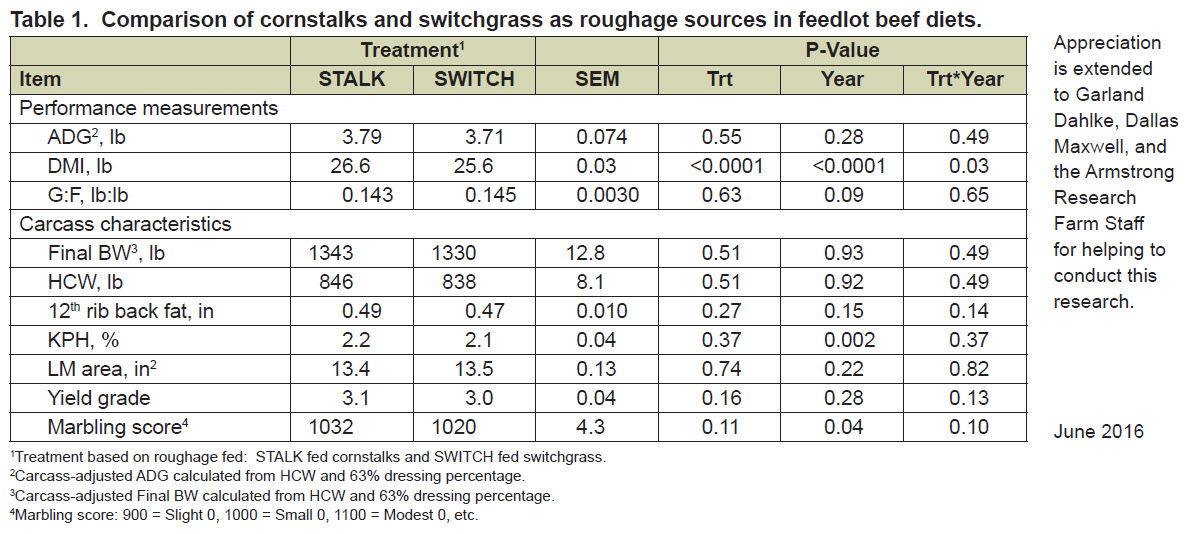Sponsoring Partner

Funded by AFRI. Learn More.
Switchgrass Hay Could Be a Useful Roughage in Beef Diets While Offering a Market Alternative to Biofuels.
Table of Contents
- Introduction
- Research Purpose
- Research Activities
- What We Have Learned
- Why Is This Important?
- For More Information
- Contributors to This Summary
Introduction
Feedlots could use hay from perennial grasses such as switchgrass as an additional source of roughage in beef rations, at the same time providing a needed alternative market for producers who grow perennial grasses for biofuel.
Research Purpose
 Producers growing switchgrass as a cellulosic ethanol feedstock must raise their crop to maturity in order to make sufficient yields of biomass. Besides biofuels, however, their market alternatives for mature switchgrass are few.
Producers growing switchgrass as a cellulosic ethanol feedstock must raise their crop to maturity in order to make sufficient yields of biomass. Besides biofuels, however, their market alternatives for mature switchgrass are few.
Researchers at the Iowa State University Armstrong Research Farm hypothesized that mature switchgrass might be used as a source of roughage, necessary for proper rumen function, in beef cattle rations. Their study looked at performance and carcass characteristics of steers fed switchgrass compared to steers fed forage of similar quality. Cornstalks were chosen for comparison because cornstalks are locally abundant, widely used, and comparable to mature switchgrass in nutrient content and digestibility.
Research Activities
The researchers conducted a feed trial that compared mature switchgrass to cornstalks as a source of roughage in beef feedlot diets. They fed a total of 247 steers, in feedlots, during the summers of 2014 and 2015. Some were fed cornstalks and others were fed switchgrass, both low-quality forages, as components of total mixed rations that were 14.2 percent roughage, with a total neutral detergent fiber (NDF) of 29 percent. The rations, consisting of corn, modified distillers grains, and mineral supplement, were otherwise comparable across treatments.
Performance data such as average daily gain (ADG) and pen dry matter intakes (DMI) were collected, as were carcass data after the steers were marketed and slaughtered.
What We Have Learned
The carcass and performance data reported in Table 1 support the hypothesis that mature switchgrass hay can be used much like cornstalks, at low inclusion rates, in feedlot rations. Steers fed a ration including switchgrass roughage were successfully fed to market weight, with performance and carcass data very comparable to the control cattle that were fed cornstalks as roughage. Steers fed a ration with switchgrass roughage were almost identical to steers fed cornstalk roughage, in average daily gain (ADG) and gain-to-feed ratio (G:F). Carcass characteristics were also very comparable across treatments.

Why Is This Important?

Switchgrass is an excellent feedstock for cellulosic ethanol but, with the bioenergy industry still developing, producers are looking for alternative markets for mature switchgrass. Switchgrass can be grazed by or harvested as hay for beef cattle. However, grown to maturity to furnish high yields of biomass, it provides little nutrition to livestock. Despite this maturity and lack of digestible nutrients, mature switchgrass seems to offer enough effective fiber to maintain rumen function and promote digestive health.
This research shows that switchgrass can be included in beef rations as roughage, much like cornstalks, without sacrificing performance or marketability of beef. In feedlots diets rich in digestible nutrients from concentrates, the roughage source may not need to be highly digestible but rather just a source of effective fiber. In this setting, switchgrass roughage could be an excellent alternative.
An available supply of affordable switchgrass roughage would benefit feedlot producers, who may increasingly compete with the cellulosic ethanol industry for cornstalks and other types of roughage. Use of switchgrass as feed also benefits producers who grow switchgrass for the biofuel industry by providing an alternative market for their crop and helping to make switchgrass production more profitable.
For More Information
- Utilization of Mature Switchgrass as Roughage in Feedlot Diets (printable PDF) – Chris Clark and Dan Loy
-
CenUSA Project Resources – information on the opportunities and challenges in developing a sustainable system for the thermochemical production of biofuels from perennial grasses grown on land marginal for row crop production. This Research Summary is part of the CenUSA Markets and Distribution Module:
- Publications:
- The Economics of Switchgrass for Biofuel – Richard Perrin
- Competition For Land Use: Why Would a Rational Producer Grow Switchgrass for Biofuel? – Keri Jacobs
- Video
- Webinar
- FAQs
- Publications:
Contributors to This Summary
Authors:
- Christopher Clark, Iowa State University Extension and Outreach Beef Field Specialist; 712-769-2650; caclark@iastate.edu
- Susan J. Harlow, Freelance Journalist
Peer Reviewer:
- F. John Hay, Extension Educator, University of Nebraska-Lincoln Extension
CenUSA Bioenergy is a coordinated research and education effort investigating the creation of a regional system in the Central US for producing advanced transportation fuels from perennial grasses on land that is either unsuitable or marginal for row crop production.* In addition to producing advanced biofuels, the proposed system will improve the sustainability of existing cropping systems by reducing agricultural runoff of nutrients in soil and increasing carbon sequestration.
CenUSA is supported by Agriculture and Food Research Initiative Competitive Grant no. 2011-68005-30411 from the USDA National Institute of Food and Agriculture.

